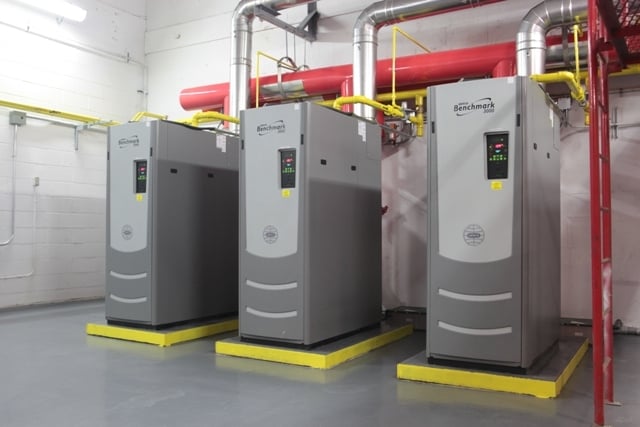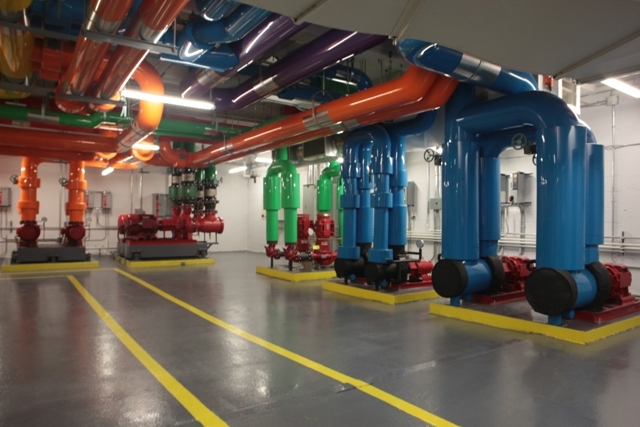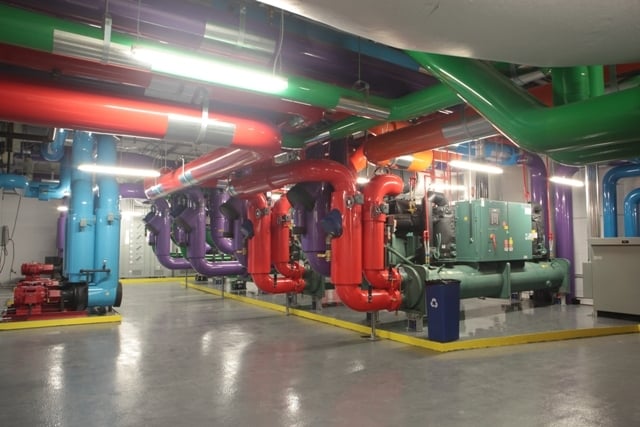Do most new sky scrapers used forced air or steam heat?

I'm writing a little bit about the history of steam heat in Chicago, and while I'm waiting to hear back from some construction people, I thought I'd just ask my question here, too.
I know (or think) NYC is on district heating, but in cities like Chicago and San Francisco, or really just cities that don't have NYC's steam network, is it more likely for a newly constructed tall building to have forced air or some sort of hydronic or steam set-up?
Thanks for any help with this question!
Jim
Comments
-
Neither. Many -- if not all -- newer buildings will use local forced air in spaces, but the air in the air handlers will be tempered using hot water or cold water (or both, particularly if humidity control is included in the mix!). Sometimes variations on what might be called mini-splits are used; depends a lot on how many you need, the design conditions, etc.Br. Jamie, osb
Building superintendent/caretaker, 7200 sq. ft. historic house museum with dependencies in New England1 -
To add to that, since the taller the building the higher the pressure at the bottom of a hot-water system, a tall building will use a steam boiler and several heat exchangers to reduce the height of the several hot-water loops. Or, they may just use steam coils in the ducts.
Older buildings like the Empire State building use steam radiators.All Steamed Up, Inc.
Towson, MD, USA
Steam, Vapor & Hot-Water Heating Specialists
Oil & Gas Burner Service
Consulting1 -
-
I've never worked in a skyscraper, but I can say I've worked in plenty of large buildings or facilities that use steam to heat large air handlers or use steam to create hot water to feed air handlers and domestic hot water.0
-
Hi Jim,
I see you're still working on this project. Give the IIT Dept of Architecture a call in Chicago. This is where most of the modern skyscrapers in Chicago were born. IIT, from what I understand, was pushing hot water instead of steam for a long time, but should be able to get you some answers. I can give them a call if you like ( IIT is my Alma Mater)...I have several current connections there, especially in the Engineering and Architecture Schools. We may be doing some R& D with the Engineers on steam heat, so stay tuned for future developments.To learn more about this professional, click here to visit their ad in Find A Contractor.0 -
The use of hydronics in a high rise building (steam is a subset of hydronics) can result in a decrease in the space taken up by mechanicals compared to a strictly forced air system. This can result in an increase in the useable space for a given height building, and that means more income to the building owner.
The greatest threat that our industry currently faces is the implementation of Variable Refrigerant Flow technologies. They have publicly stated that they intend to take over ALL markets with their products. And they could do that. In fact they could write a check and buy all the hydronic equipment manufacturers in North america, and not put a dent in their checking account.
A very sage and wise group of hydronic equipment manufacturers have formed a group to counter this threat. It is called the Hydronics Industry Alliance- Commercial.
If you are a manufacturer reading this and are interested in joining their efforts, contact me at mark.eatherton@radiantpros.org
The war has already begun, and the first shots fired, and the Canadians are feeling the effects. For the record, I am not against the use of refrigerant based systems for use WITH hydronics. I am against the use of large distributed refrigerant systems (VRF), with their inherent refrigerant leaks, and poor operating efficiencies during peak loading. (See ASHRAE building study and others)
Hydronics has and will always be the most efficient method of providing excellent human comfort. It's why water is the gold standard as it pertains to heat transfer.
ME0 -
I'm confused.Mark Eatherton said:The use of hydronics in a high rise building (steam is a subset of hydronics) can result in a decrease in the space taken up by mechanicals compared to a strictly forced air system. This can result in an increase in the useable space for a given height building, and that means more income to the building owner.
The greatest threat that our industry currently faces is the implementation of Variable Refrigerant Flow technologies. They have publicly stated that they intend to take over ALL markets with their products. And they could do that. In fact they could write a check and buy all the hydronic equipment manufacturers in North america, and not put a dent in their checking account.
A very sage and wise group of hydronic equipment manufacturers have formed a group to counter this threat. It is called the Hydronics Industry Alliance- Commercial.
If you are a manufacturer reading this and are interested in joining their efforts, contact me at mark.eatherton@radiantpros.org
The war has already begun, and the first shots fired, and the Canadians are feeling the effects. For the record, I am not against the use of refrigerant based systems for use WITH hydronics. I am against the use of large distributed refrigerant systems (VRF), with their inherent refrigerant leaks, and poor operating efficiencies during peak loading. (See ASHRAE building study and others)
Hydronics has and will always be the most efficient method of providing excellent human comfort. It's why water is the gold standard as it pertains to heat transfer.
ME
Who's the company you're talking about? Who is "they" ?
Single pipe 392sqft system with an EG-40 rated for 325sqft and it's silent and balanced at all times.
0 -
Lots of small water to air heat pumps. A big loop of 70º water. A heat -x and cooling tower and a tiny electric boiler. No expensive equipment or controls. Occupancy changes simple to accommodate . Redundant. Tenants pay their own energy bill. You don't have to install the heat pumps until the space is leased.
There was an error rendering this rich post.
0 -
Once heard a talk by a ME about his experiences with big buildings. Each variation has negatives.0
-
Who's the company you're talking about? Who is "they" ?
Pick one. The most prominent manufactures of such Air-Conditioning systems are Japanese with companies like: Daikin, Mitsubishi Electric, Mitsubishi Heavy VRF, Fujitsu, Hitachi, Sanyo / Panasonic and Toshiba. This is who "they" are.
ME0 -
It is a lot of small heat pumps working off cooling tower and condensing boilers. I usually set up boilers to maintain 100 F. So heat pumps cooling water and heating space. Summer mode is reversed. heat pumps cooling space and heating water circulating through cooling towers.Gennady Tsakh
Absolute Mechanical Co. Inc.1 -
If I had to guess what's most common,then separate air handlers for each floor. Fire control factors. If heat is necessary generally peripheral terminals. Steam makes more sense for tall buildings than hot water. Again I'd guess electric radiant is most common. Turned on early AM before demand charges kick in.0
-
The larger and taller buildings (which have large steam coils for ventilation)) are converted to glycol systems and a variety of condensing and near condensing boilers. Some have perifral supplementary base board cooling/heating. In the pictured example, we have 4 vertical zones. When I took the pictures in February 2015, it was below 0F. Three zones were heating while the South zone was cooling. There is complet or near complete energy recovery for both cooling and heating. It was $5 million for us and $2 million in control.




1 -
>>There is complet or near complete energy recovery for both cooling and heating.<<
So what are the boilers for? If only for peripheral baseboards isn't steam simpler and cheaper than glycol? In my day we heated glycol with steam. Worried that direct firing can hurt glycol.0 -
One World Trade Center uses Con Ed steam, which goes to shell-and-tube heat exchangers. The radiators run on hot water.Retired and loving it.0
-
The boilers heat glycol for the heat exchangers in the main ducts, air handling units and the peripheral baseboards0
-
Where are those boilers located? All on the roof or sub-basement or on various floors for each zone?0
-
All are on the roof.0
-
Jumper, there are times that a water source heat pump systems recovers 100% of its energies from one side of the building to the other.jumper said:>>There is complet or near complete energy recovery for both cooling and heating.<<
So what are the boilers for? If only for peripheral baseboards isn't steam simpler and cheaper than glycol? In my day we heated glycol with steam. Worried that direct firing can hurt glycol. </p>
And then there are also times that there is too much internal heat being generated, and it is rejected via cooling towers,
During periods of design conditions, unless we are talking about a super insulated building, the building will require augmentation heat. This is not a new concept, and it has been around for many years. There are even some fire protection systems that utilize this method because the water is kept between 65 and 75 degrees F., and the heat pumps use that as a source or a sink. It's referred to as a Tri Water system, when also doing fire protection. Saves a LOT of pipe and labor.
Due to the low temperature of operation, it is also not uncommon to see them piped in PVC, which is even less expensive than steel pipe.
ME
1 -
Indy has the 2nd largest district steam system after NYC. Also have a big chilled water network. See https://www.flickr.com/photos/22599263@N04/albums/72157664809340546 for pictures. Our skyscrapers were built before the chilled water system was built but most of downtown is on the steam network. It varies in buildings how it is used. I gather most convert to hot water to fan coils or some perimeter radiation. All of the tall buildings would have their own chiller now. Older buildings are tapping into district chilled water as their plants fail. One tall bank building has WSHPs.
More on Indy's district system. 60% of the steam comes from burning gas in a plant across from Lucas Oil Stadium where the Colts play. It was just converted from coal. 40% comes from burning garbage. There are 6 chilled water plants on the network. The flickr link above is the main one with 40K ton or more of capacity. There's a small plant on the grounds of the steam plant, a new plant on the north side of downtown, a plant on the college campus west of downtown, a steam & chiller plant beside the new city hospital and a weirdly designed chiller plant left over from where the old city hospital was.
0 -
The NYC Freedom Tower has Slant/Fin element within a custom cover around the perimeter of the floors. It is copper element so I believe it uses hot water and not steam. in addition to increasing comfort level, perimeter heat helps prevent water condensation from forming on the inside of windows.
Our product is installed in other "sky scrapers" as well. Some using wall mounted covers and some recessed into the floor in a trough.
Keith Muhlmeister
Slant/Fin0
Categories
- All Categories
- 87.3K THE MAIN WALL
- 3.2K A-C, Heat Pumps & Refrigeration
- 61 Biomass
- 429 Carbon Monoxide Awareness
- 120 Chimneys & Flues
- 2.1K Domestic Hot Water
- 5.8K Gas Heating
- 115 Geothermal
- 166 Indoor-Air Quality
- 3.7K Oil Heating
- 77 Pipe Deterioration
- 1K Plumbing
- 6.5K Radiant Heating
- 395 Solar
- 15.7K Strictly Steam
- 3.4K Thermostats and Controls
- 56 Water Quality
- 51 Industry Classes
- 50 Job Opportunities
- 18 Recall Announcements






